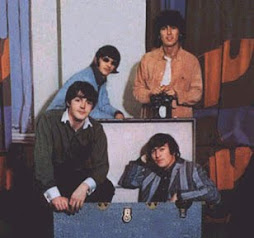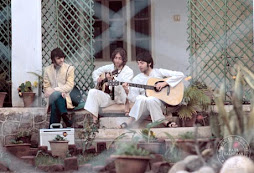I was in Naples, Florida a few weeks ago. I was in an Irish pub, McCabe's and they had a singer/guitarist there. The audience requested a few Beatles songs but the musician wouldn't play most of the requests. Finally he settled on "Revolution." That was a great song, Revolution. John had been involved with Yoko Ono and he was really starting to come out as far as speaking his mind about politics. John had been chiding the late Beatle manager Brian Epstein about speaking out against the Vietnam War during their last tour. Brian told them not to comment on it. John was in enough trouble about his Jesus comments. "The Beatles are bigger than Jesus now." And then he said "Jesus was all right but his disciples were thick and ordinary." The Ku Klux Klan sent the Beatles a death threat to their hotel. At a concert down South, Memphis I believe, John and George winced when a boy lit off a pack of firecrackers at a Beatle concert. They looked at each other to see if one of them had been shot. George said "America was mad. It had only been a few years since Kennedy was killed." Revolution was recorded in several forms. At George's home in Esher, a demo was recorded with John singing double tracked and playing on an acoustic guitar. George had a four track recorder so a few overdubs were done. For the most part, this first version of Revolution had a very homey feel to it like the Beatles were jamming in your living room. So cool. Later on the White Album "Revolution 1" was recorded. It first it was much longer. Yoko was reading a passage. John added in sound effects that he later transferred over on to "Revolution 9." He can be heard vomiting, having orgasms, doing primal screams, and all such audio avante garde influenced by Yoko Ono and her conceptual performance art. This extended version of Revolution was hated by the other Beatles. Paul was doing multiple takes of "Obla Di, Obla Da" as well as writing songs and producing demos for Mary Hopkin and a group he reformed called Badfinger. For Mary Hopkin, Paul produced a demo called "Goodbye." For Badfinger he produced "Come and Get It." The song writing credits were to Lennon and McCartney but Paul wrote and produced the songs for his new found talent.
John was not sure how he wanted go with the intention of his Revolution. He sang "don't you know that you can count me out-in!" He didn't know if he was for or against a Revolution. He was very much involved with Yoko at the time. He came back from India disillusioned from the Maharishi. He suspected the Indian guru of trying to seduce some women in the Beatles entourage. But if the truth be told, he was using that rumor as an excuse to get back to London to be with Yoko and take drugs. He had been experimenting with LSD and he missed the trips. Yoko was taking heroine and soon John would be showing up at Beatles recording sessions in a lethargic state. Paul would try in desperation to rally the Beatles to do the next take of Obladi Oblada and John would simply smile at him and laugh and as soon as he had the chance would go off with Yoko. Yoko would follow John into the bathroom. She never left him alone. She was sick and put a bed in the recording studio. The other Beatles were livid. Before Yoko, the Beatle wives and girlfriends were never allowed in the recording studio. Now here was Yoko, not only present in the studio, but sleeping in the studio and making critical comments. "Beatles do this. Paul play piano like this." Paul was shocked. Here was John's bird telling him how to play music.
Later on, when Paul recorded "Hey Jude" as a new Beatles single. John decided to re-record "Revolution" on the other side of the single making the disc a Double A single. Two hits on one disc. Paul's Hey Jude on one side. John's Revolution on the other side. He brought in Nicky Hopkins to play piano. Special care was taken to produce the lead guitar that was recorded directly into the mixing board. John overloaded the circuits and created a distinctive distortion sound. The opening machine gun sounding guitar riff is his signature. John Lennon was breaking the studio rules again. Many of the recording artists of that late 1960s time period were producing loud distorted guitar sounds. Eric Clapton. Jimi Hendrix. Now John was adding his own sound. He would produce a similar sound with "Cold Turkey" as a solo artist with Yoko and then aided by Eric Clapton, a friend of John and George. But here in "Revolution" the sound is John's sound. It is the machine gun of a Revolution, loud and violently abrasive. It was the perfect backdrop of student anti-war protests, LSD trips, hippies sleeping in city parks, people like John and Yoko living in sin and without a care in the world. The straight world was in shock. Who was this long haired freak wearing women's glasses sleeping with a Japanese woman? It was John Lennon. He was crazy and every kid loved him and every kid's parent hated him. He didn't need to say that the Beatles were bigger than Jesus. Soon a man named Charles Manson would be telling his followers to listen to the Beatles albums and listen to Revolution. And Charlie Manson and his followers thought he was Jesus.
Saturday, March 27, 2010
Subscribe to:
Post Comments (Atom)

























Interesting, thanks :)
ReplyDeleteI've never liked that yoko.